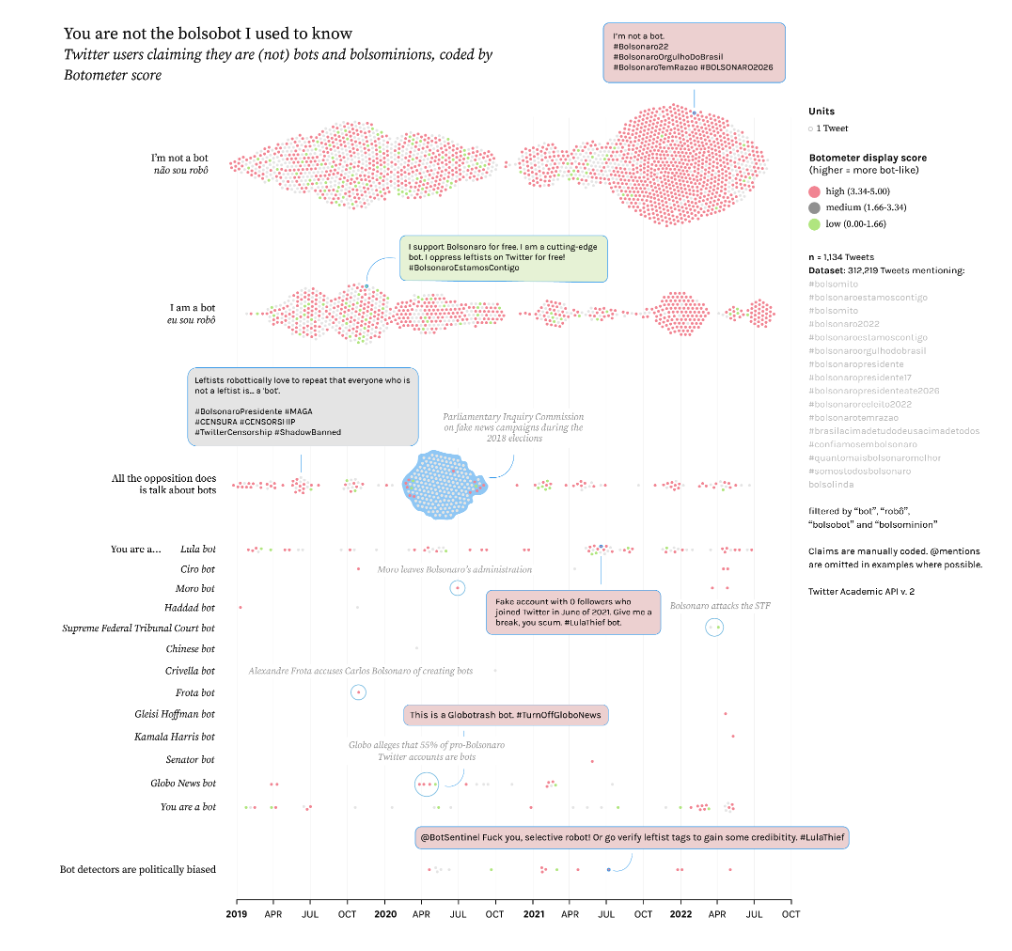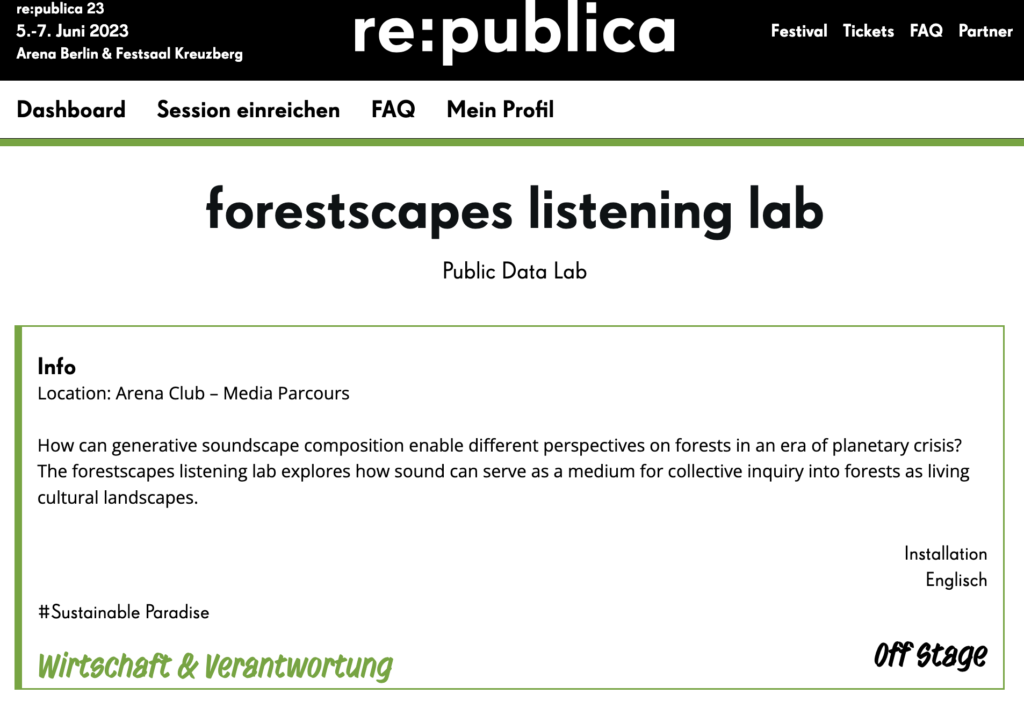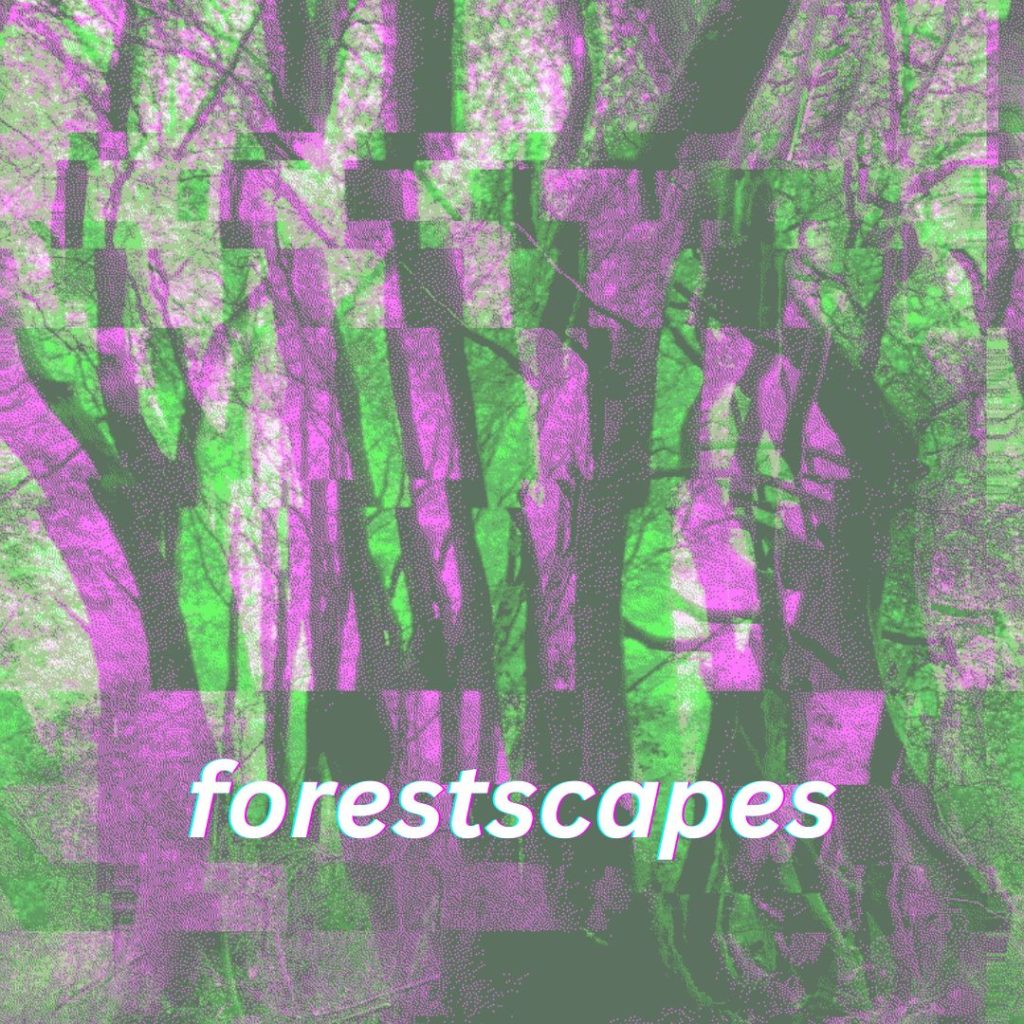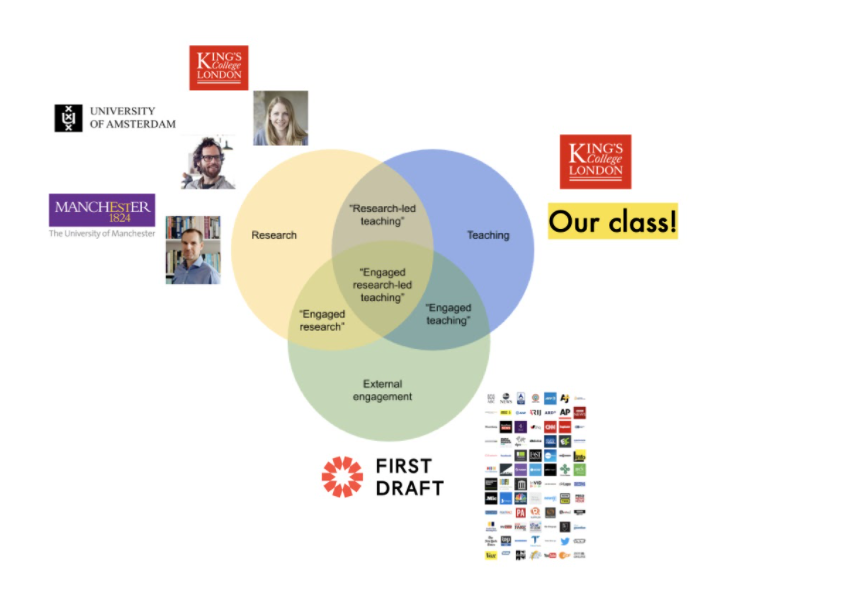There will be a launch event for the Convergence special issue on critical technical practice(s) in digital research on Wednesday 10th July, 2-4pm (CEST). This will include an introduction to the special issue, brief presentations from several special issue contributors, followed by discussion about possibilities and next steps. You can register here.
Category: Projects
New article on cross-platform bot studies published in special issue about visual methods

An article on “Quali-quanti visual methods and political bots: A cross-platform study of pro- & anti- bolsobots” has just been published in the special issue “Methods in Visual Politics and Protest” of the Journal of Digital Social Research, co-authored by Public Data Lab associates Janna Joceli Omena, Thais Lobo, Giulia Tucci, Elias Bitencourt, Emillie de Keulenaar, Francisco W. Kerche, Jason Chao, Marius Liedtke, Mengying Li, Maria Luiza Paschoal, and Ilya Lavrov.
The article provides methodological contributions for interpreting bot-associated image collections and textual content across Instagram, TikTok and Twitter/X, building on a series of data sprints conducted as part of the Public Data Lab “Profiling Bolsobot Networks” project.
The full text is available open access here. Further details and links can be found at the project page. Below is the abstract:
Computational social science research on automated social media accounts, colloquially dubbed “bots”, has tended to rely on binary verification methods to detect bot operations on social media. Typically focused on textual data from Twitter (now rebranded as “X”), these methods are prone to finding false positives and failing to understand the subtler ways in which bots operate over time and in particular contexts. This research paper brings methodological contributions to such studies, focusing on what it calls “bolsobots” in Brazilian social media. Named after former Brazilian President Jair Bolsonaro, the bolsobots refer to the extensive and skilful usage of partial or fully automated accounts by marketing teams, hackers, activists or campaign supporters. These accounts leverage organic online political culture to sway public opinion for or against policies, opposition figures, or Bolsonaro himself. Drawing on empirical case studies, this paper implements quali-quanti visual methods to operationalise specific techniques for interpreting bot-associated image collections and textual content across Instagram, TikTok and Twitter/X. To unveil the modus operandi of bolsobots, we map the networks of users they follow (“following networks”), explore the visual-textual content they post, and observe the strategies they deploy to adapt to platform content moderation. Such analyses tackle methodological challenges inherent in bot studies by employing three key strategies: 1) designing context-sensitive queries and curating datasets with platforms’ interfaces and search engines to mitigate the limitations of bot scoring detectors, 2) engaging qualitatively with data visualisations to understand the vernaculars of bots, and 3) adopting a non-binary analysis framework that contextualises bots within their socio-technical environments. By acknowledging the intricate interplay between bots, user and platform cultures, this paper contributes to method innovation on bot studies and emerging quali-quanti visual methods literature.
forestscapes listening lab at re:publica 23, Berlin, 5-7th June

As part of the forestscapes project we’re organising a listening lab at re:publica 23, the digital society festival in Berlin, 5-7th June 2023:
How can generative soundscape composition enable different perspectives on forests in an era of planetary crisis? The forestscapes listening lab explores how sound can serve as a medium for collective inquiry into forests as living cultural landscapes.
The soundscapes are composed with folders of sound from different sources, including field recordings from researchers, sound artists and forest practitioners, as well as online sounds from the web, social media and sound archives. They are composed using custom scripts with the open source supercollider software as well as open source norns device, a “sound machine for the exploration of time and space”.
The re:publica installation will include soundscapes from workshops in London and Berlin – including some new pieces from the Environmental Data, Media, and the Humanities hackathon last week.
Cross-posted from jonathangray.org.
Introducing forestscapes and open call for forest sounds

Soundscapes as method
How can soundscapes be used as a way to attend to forest life and the many different ways that we narrate and relate to forests, forest issues and forest protection and restoration efforts?
Forests and their wider ecologies are presented not only as sites of conservation and relaxation, but also as crucial infrastructures in addressing and building resilience against the effects of climate change; habitats for endangered species; hotspots of biodiversity; part of poverty alleviation programmes; sites for ecotourism, health and wellbeing; scenes of neocolonial afforestation; backdrops for corporate greenwashing; landscapes of danger, violence, destruction and resource conflicts; and places where different kinds of planetary futures may emerge. Forests are involved in collective life in many ways.
In this context, the forestscapes project will explore, document and demonstrate generative arts-based methods for recomposing collections of sound materials to support “collective inquiry” into forests as living cultural landscapes. It aims to facilitate interdisciplinary exchanges between natural scientists, social scientists, arts and humanities researchers, artists and public-spirited organisations and institutions working on forest issues.
While many previous works have explored sound as a medium for sensory immersion, (e.g. field recordings), forestscapes explores how recomposing sound material may explore forests as mediatised and contested cultural landscapes: diverse sites of many different (and marginalised) kinds of beings, relations, histories and representations. As part of the project we will co-create new sound works, as well as generative composition techniques using open source software and hardware.
Research on visual methods has explored how to work with “folders of images”, including formats for the re-arrangement of images for collective interpretation. Forestscapes will explore generative methods and techniques for working with “folders of sound” – whether folders of site-based recordings or collections of sounds associated with a particular place gathered from the web and social media.
Further details and materials from the project will be added here.
Call for folders of forest sounds
As part of the project we have an open call for folders of forest sounds. If you have a collection of forest sounds related to a particular site and you’d be interested in exploring soundscaping techniques, we’d love to hear from you.
What? We welcome sounds collected in different contexts, i.e. research projects involving forests in some ways (e.g. ecological restoration, study of climate change impacts, fieldwork, etc); sounds recorded during walks and trips; as well as material collected online.
How? You can tell us about your folders of forest sounds here.
Who? We’re keen to hear from everyone with collections of forest sounds – whether you’re a forest scientist with bioacoustic recordings; an environmental organisation exploring sound as a medium of community engagement; a new media researcher gathering online materials; an ethnographer working with sound materials; a musician working with field recordings from a particular forest site; an artist interested in generative compositional techniques with ecological sounds; or a walker who has gathered a collection of sounds from a forest you often go to.
When? Please submit your files by 17th March 2023.
The forestscapes project is a collaboration between the Department of Geography, the Department of Digital Humanities, the Centre for Digital Culture, the Centre for Attention Studies, the Digital Futures Institute and the Environmental Humanities Network at King’s College London, together with the Public Data Lab. It is supported by the National Environmental Research Council.
Exploring forest hashtags in COP27 Twitter with the European Forest Institute
The following is a cross-post from Rina Tsubaki at the European Forest Institute, drawing on digital methods recipes and approaches developed with the Public Data Lab as part a broader collaboration around the SUPERB project on upscaling forest restoration.
Elon Musk’s takeover of Twitter has prompted confusion among its users and concerns about the platform’s future. Musk’s tweets are gathering daily attention due to large-scale layoffs and safety concerns around the new paid blue verification mark. To make things worse, as its engineers are on their way out of the door, users are also experiencing various technical glitches on the platform. Millions of users – including journalists, researchers and organisations – are already signing up on alternative platforms to be prepared for the platform’s deterioration and demise.
While no one can predict Twitter’s future, it remains widely used by politicians, scientists, companies, NGOs and influencers who are still busy posting on the platform. This includes COP27 in Egypt, where Twitter was one of the main platforms to report on the event. #cop27 has been tweeted over 2.85 million times since 5 November 2022.
Social media platforms can give us additional insights into how broader publics make connections between forest restoration and other social, economic and environmental issues. To see which issues and narratives around forest restoration have been brought up on Twitter in the lead-up to the event, we’ve carried out a series of small explorations based on the digital methods recipes developed by our colleagues at the Department of Digital Humanities, King’s College London and the Public Data Lab who are part of the SUPERB consortium led by EFI. This has been a good way to see if EFI could use these methods independently to understand international events as they unfold.
We usually see a spike in hashtag usage a few days before global events like the COPs. Using #cop27, we collected 217,189 tweets between 5 and 7 November 2022. We then examined the top 1000 hashtags to see which kinds of forest-related issues are present.
Continue readingArticle on “Engaged research-led teaching: composing collective inquiry with digital methods and data”

A new article on “Engaged research-led teaching: composing collective inquiry with digital methods and data” co-authored by Jonathan Gray, Liliana Bounegru, Richard Rogers, Tommaso Venturini, Donato Ricci, Axel Meunier, Michele Mauri, Sabine Niederer, Natalia Sánchez-Querubín, Marc Tuters, Lucy Kimbell and Anders Kristian Munk has just been published in Digital Culture & Education.
The article is available here, and the abstract is as follows:
This article examines the organisation of collaborative digital methods and data projects in the context of engaged research-led teaching in the humanities. Drawing on interviews, field notes, projects and practices from across eight research groups associated with the Public Data Lab (publicdatalab.org), it provides considerations for those interested in undertaking such projects, organised around four areas: composing (1) problems and questions; (2) collectives of inquiry; (3) learning devices and infrastructures; and (4) vernacular, boundary and experimental outputs. Informed by constructivist approaches to learning and pragmatist approaches to collective inquiry, these considerations aim to support teaching and learning through digital projects which surface and reflect on the questions, problems, formats, data, methods, materials and means through which they are produced.
Profiling Bolsobot Networks

Blog post by By Emillie de Keulenaar, Francisco Kerche, Giulia Tucci, Janna Joceli Omena and Thais Lobo [alphabetical order].
Brazilian political bots have been active since 2014 to influence elections through the creation and maintenance of fake profiles across social media platforms. In 2017, bots’ influence and forms of interference gained a new status with the emergence of “bot factories” acting in support of Jair Bolsonaro’s election and presidency. What we call bolsobots are inauthentic social media accounts created to consistently support Bolsonaro’s political agenda over the years, namely Bolsonaro as a political candidate, President, and avatar of a conservative and militaristic vision of Brazilian history, where social discipline, Christian values and a strong but economically liberal state aim to uproot the decadent influence of “socialism” (Messenberg, 2019). From viralising or spreading hashtags to establishing target audiences with pro-Bolsonaro “slogan accounts” with a strong, visual presence, these bots have also been tied to documented disinformation campaigns (Lobo & Carvalho, 2018; Militão & Rebello, 2019; Santini, Salles, & Tucci, 2021). Despite the efforts of social media platforms, including Whatsapp and Telegram, to restrict their more or less coordinated inauthentic activities (Euronews, 2021), bolsobots still exist and actively adapt to online cultures.
Accounting for the upcoming Brazilian 2022 elections, the project Profiling Bolsobots Networks investigates the practices of pro- and anti- Bolsonaro bots across Instagram, Twitter and TikTok. It aims to empirically demonstrate how to capture the operation of bolsobot networks; the types of accounts that constitute bot ecologies; how (differently) bots behave and promote content; how bolsobots change over time and across platforms, pending to different cultures of authenticity; and, finally, how platform moderation policies may impact their activities over time. In doing so, the project will produce a series of research reports on “bolsobot” networks and digital methods recipes to further the understanding of bots’ presence and influence in the communication ecosystem.
We are (so far) a group of six scholars collaborating on this project: Janna Joceli Omena (Public Data Lab / iNOVA Media Lab / University of Warwick), Thais Lobo (Public Data Lab / King’s College London), Francisco Kerche (Universidade Federal do Rio de Janeiro), Giulia Tucci (Universidade Federal do Rio de Janeiro), Emillie de Keulenaar (OILab / University of Groningen) and Elias Bitencourt (Universidade do Estado da Bahia). Below are some of the preliminary outputs of the project.
Continue reading“Ways of Listening to Forests” workshop at Critical Zones exhibition, ZKM, 26th November 2021
There will be a free online workshop on 26th November 2021 featuring our forest listening project as part of the Critical Zones exhibition curated by Bruno Latour and Peter Weibel at the ZKM Center for Art and Media. This builds on a previous workshop in the summer. The sound pieces are now online as part of the Critical Zones exhibition and can be downloaded from the project website.

This piece is cross-posted from jonathangray.org.
Investigating infodemic – researchers, students and journalists work together to explore the online circulation of COVID-19 misinformation and conspiracies

Over the past year researchers and students at institutions associated with the Public Data Lab have contributed to a series of collaborative digital investigations into the online circulation of COVID-19 misinformation and conspiracies.
Researchers and students contributed to a series of “engaged research led teaching” projects developed with journalists, media organisations and non-governmental organisations around the world.

These were undertaken in association with the Arts and Humanities Research Council funded project Infodemic: Combatting COVID-19 Conspiracy Theories, which explores how digital methods grounded in social and cultural research may facilitate understanding of WHO has described as an “infodemic” of misleading, fabricated, conspiratorial and other problematic material related to the COVID-19 pandemic.
These projects led to and contributed to a number of stories, investigations and publications including:
- A set of digital investigation recipes with First Draft as well as a piece on “Finding misinformation with ‘rumor cues’”
- A long read on investigating troubling content on Amazon with the European Journalism Centre
- A piece on “Amazon Is Pushing Readers Down A “Rabbit Hole” Of Conspiracy Theories About The Coronavirus” with BuzzFeed News
- A piece on “Conspiracy theories run wild on Amazon” with Politico
- A piece on “Big Tech’s trying to stop coronavirus misinformation. It’s not enough.” with Politico
- A piece on “Complotten in een crisis: gouden combinatie”, NOS (Dutch Broadcasting Foundation)
- A piece on “How Amazon became an engine for anti-vaccine conspiracy theories” with Fast Company
- A piece on “Amazon is helping fund conspiracy theories” with Media Matters
